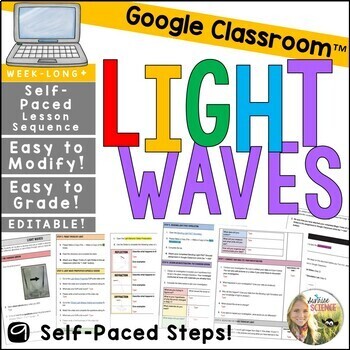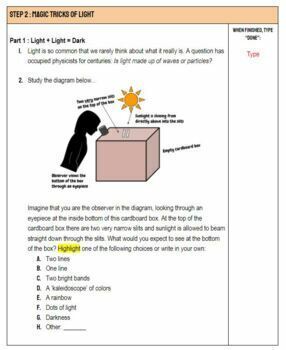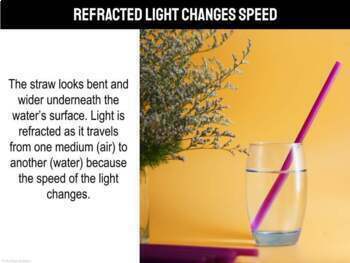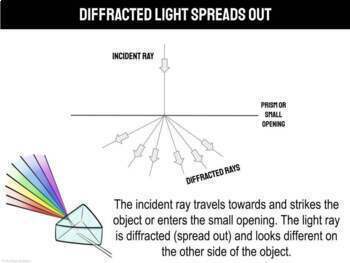Light Waves Lesson | Reflection Refraction | Electromagnetic Spectrum
- PDF
- Google Apps™
- Internet Activities

Also included in
- This is a bundle of all of my resources for teaching physical science at the middle school level! These resources include a mix of Cornell Doodle Notes, labs, demonstrations, inquiry activities, self-paced digital 5E lessons, manipulatives, projects, pixel art review activities, and assessments. IPrice $297.00Original Price $384.06Save $87.06
- This is a bundle of all of my resources for teaching physical science at the 8th grade level WITHOUT the Cornell Doodle Notes included. I put together this bundle upon request from customers who had already purchased my Growing Bundle of Physical Science Cornell Doodle Notes or my Entire Store BundPrice $187.00Original Price $246.28Save $59.28
- Looking for fun, engaging, no-prep ways to teach your physical science students about WAVES? This unit covers sound and light waves, the electromagnetic spectrum, and information transfer using analog and digital signals. This bundle contains SO much content for teaching about the nature and behavioPrice $36.00Original Price $45.27Save $9.27
Description
In this week-long self-paced lesson, students will learn about the behavior of light waves, including how they are absorbed, transmitted, reflected, refracted, and diffracted to produce lots of beautiful phenomena. Students will be engaged by a phenomenon and as they progress through the lesson, they will build on their understanding of what's happening with light waves to produce the phenomenon.
Students will work through 9 self-paced steps on a Google Doc. They will also work on supporting documents that are linked to the main Google Doc. As students finish the work for each Step, they type "Done" in the right-hand column of their table. This assignment can be completely facilitated using Google Classroom. It's easy to modify for differentiation and it's easy to grade!
This lesson incorporates different learning modes and activities. The variety of activities that make up this lesson include:
- making observations and asking questions about phenomena related to the behavior of light
- using Google Drawings to create digitals models of phenomena
- video clip activities
- viewing and taking notes on a Slides presentation about the behavior of light
- a Bending Light PhET Simulation Lab
- designing (and optionally conducting) an at-home mini-investigation to explain a phenomenon
- explaining light behavior using scientific vocabulary learned in the lesson
- a quiz on light waves (Google Form)
This download includes links to make copies of all parts of this lesson into your Google Drive. Answer keys are included. Detailed teacher notes explain how to facilitate this lesson using Google Classroom, how to edit and modify any of the documents, and how to efficiently grade this assignment.
My students have responded so well to this distance learning lesson format because they like that they can work at their own pace. I love that I can set a due date and then pop into their document when I want to get a sense of their progress. Students will attach supporting documents to the assignment in Google Classroom, which makes grading super easy and accessible.
For a distance learning scenario, I suggest for students to complete one or two Steps per day, so I give them about 7 days to complete this entire lesson. In the meantime, I check in on everyone's progress a couple of times to make comments, answer questions, and interact with the students. This lesson is perfect for classrooms with 1:1 devices and could also be used in class. I would allow 4 to 5 50-minute class periods for this lesson.
This lesson was written to satisfy NGSS MS-PS4-2 : Develop and use a model to describe that waves are reflected, absorbed, or transmitted through various materials, and the DCIs of PS4.B: Electromagnetic Radiation.
Please view the Preview to get a better idea of what is included!
You may also be interested these resources:
Electromagnetic Waves Cornell Doodle Notes
Mechanical Waves Cornell Doodle Notes
Sound Waves Self-Paced Digital Lesson
Analog and Digital Signals Self-Paced Digital Lesson
Thanks for looking!
Sunrise Science








